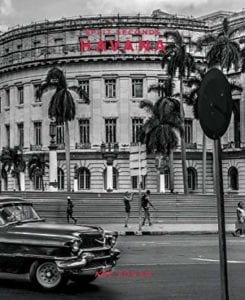
“Split Seconds Havana features the people, the architecture and, of course, the iconic ‘50s era cars of Cuba’s capital city. The presentation is candid, direct and thought-provoking but never unkind or judgmental.
The images tell the story. Kogan is an International Independent Publishers Gold Award winner for his photography.” —splitsecondsphotos.com
Shelf Unbound: You took these photos in Havana in 2015. What interested you in photographing the people of Cuba?
Abe Kogan: They are a fascinating mix of people. Downtrodden in an economic sense and more, yet high in spirit. They carry themselves with dignity and poise. An underlying elegance is ever present.
Also, loving Cuban music, which to me comes in third place after Jazz and Brazilian Jazz samba/Bossa nova. Any people that can compose, play and vibrate to their music must also be visually alluring and captivating and meaningful to photograph, don’t you think?
But also, I was smelling change in the air. Some would say my nose is defective and that major change has been occurring over the last 20 years. And it has. Still I felt that there would perhaps be a serious spike in the rate of change that could speed like wildfire. So I decided that I had better go sooner rather than later.
Shelf Unbound: You talk about taking these “split second” photographs. What can we see in a photo that we would miss in just looking at something?
Kogan: This is tricky. If a subject is lost in a moment of thought and stationary or transfixed there won’t be any difference between the video capture (looking) and a photograph of that someone or a group of people. Still though, the split second freezing will record for you what you were looking at, and will bring back that longer moment and mood and interplay that you would have had when looking at the stationary moment.
Yet when you can witness a split second from within a moving and rapidly changing sequence, that’s where the camera excels. With luck, you may have before you a visual and mood moment that could have been lost when just looking. Or you may have missed that moment altogether. Like a half expression. Or an in-between moment that the eye has no way of freezing or becoming cognizant of. The eye roves and views like a movie camera. A camera can bring to you what you could not see no matter how carefully or focused you may have been.
Shelf Unbound: What are your impressions of the people of Cuba?
Kogan: Warm, communicative, engaging, curious, ready for a laugh. The opposite of boring or complacent. I sense that Habaneros would like to have change and opportunity to engage in a wider capacity with the world at large. What comes to mind are the endless groups of people, mostly young, but not only, with their laptops, tablets and phones sitting outside banks or hotels. Why is this? Because someone within the bank or hotel or other institution would slip them the password that would enable them to get a free connection which otherwise is quite prohibitively costly. These wonderful poachers would sit on pavement or stone or if available a bench as close or far away as the connection would allow. Serene, serious, browsing, studying, viewing, absorbing for the future. Like a midnight outdoor classroom. Fabulous.
Shelf Unbound: What makes Cuba different from anywhere else you have visited?
Kogan: I cannot speak for Cuba. I focused on Havana. But if Havana speaks for Cuba, then it has to be an underdevelopment. A broken potential. A pronounced interruption. This is even more readily recognizable by what one does not see as opposed to what one witnesses.
Shelf Unbound: What do you want viewers to take away from seeing your photos?
Kogan: A desire to see Cuba for themselves before it changes and loses some of its distinctiveness.
